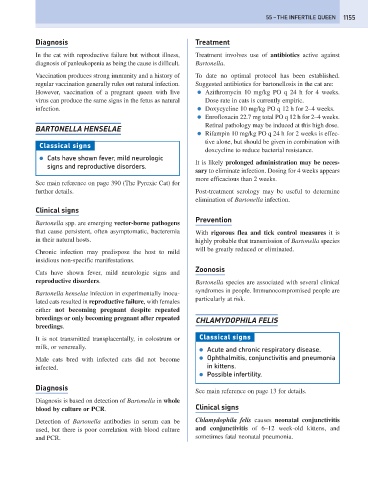Page 1163 - Problem-Based Feline Medicine
P. 1163
55 – THE INFERTILE QUEEN 1155
Diagnosis Treatment
In the cat with reproductive failure but without illness, Treatment involves use of antibiotics active against
diagnosis of panleukopenia as being the cause is difficult. Bartonella.
Vaccination produces strong immunity and a history of To date no optimal protocol has been established.
regular vaccination generally rules out natural infection. Suggested antibiotics for bartonellosis in the cat are:
However, vaccination of a pregnant queen with live ● Azithromycin 10 mg/kg PO q 24 h for 4 weeks.
virus can produce the same signs in the fetus as natural Dose rate in cats is currently empiric.
infection. ● Doxycycline 10 mg/kg PO q 12 h for 2–4 weeks.
● Enrofloxacin 22.7 mg total PO q 12 h for 2–4 weeks.
Retinal pathology may be induced at this high dose.
BARTONELLA HENSELAE
● Rifampin 10 mg/kg PO q 24 h for 2 weeks is effec-
tive alone, but should be given in combination with
Classical signs
doxcycline to reduce bacterial resistance.
● Cats have shown fever, mild neurologic
It is likely prolonged administration may be neces-
signs and reproductive disorders.
sary to eliminate infection. Dosing for 4 weeks appears
more efficacious than 2 weeks.
See main reference on page 390 (The Pyrexic Cat) for
further details. Post-treatment serology may be useful to determine
elimination of Bartonella infection.
Clinical signs
Prevention
Bartonella spp. are emerging vector-borne pathogens
that cause persistent, often asymptomatic, bacteremia With rigorous flea and tick control measures it is
in their natural hosts. highly probable that transmission of Bartonella species
will be greatly reduced or eliminated.
Chronic infection may predispose the host to mild
insidious non-specific manifestations.
Zoonosis
Cats have shown fever, mild neurologic signs and
reproductive disorders. Bartonella species are associated with several clinical
syndromes in people. Immunocompromised people are
Bartonella henselae infection in experimentally inocu-
particularly at risk.
lated cats resulted in reproductive failure, with females
either not becoming pregnant despite repeated
breedings or only becoming pregnant after repeated CHLAMYDOPHILA FELIS
breedings.
It is not transmitted transplacentally, in colostrum or Classical signs
milk, or venereally. ● Acute and chronic respiratory disease.
Male cats bred with infected cats did not become ● Ophthalmitis, conjunctivitis and pneumonia
infected. in kittens.
● Possible infertility.
Diagnosis
See main reference on page 13 for details.
Diagnosis is based on detection of Bartonella in whole
blood by culture or PCR. Clinical signs
Detection of Bartonella antibodies in serum can be Chlamydophila felis causes neonatal conjunctivitis
used, but there is poor correlation with blood culture and conjunctivitis of 6–12 week-old kittens, and
and PCR. sometimes fatal neonatal pneumonia.

